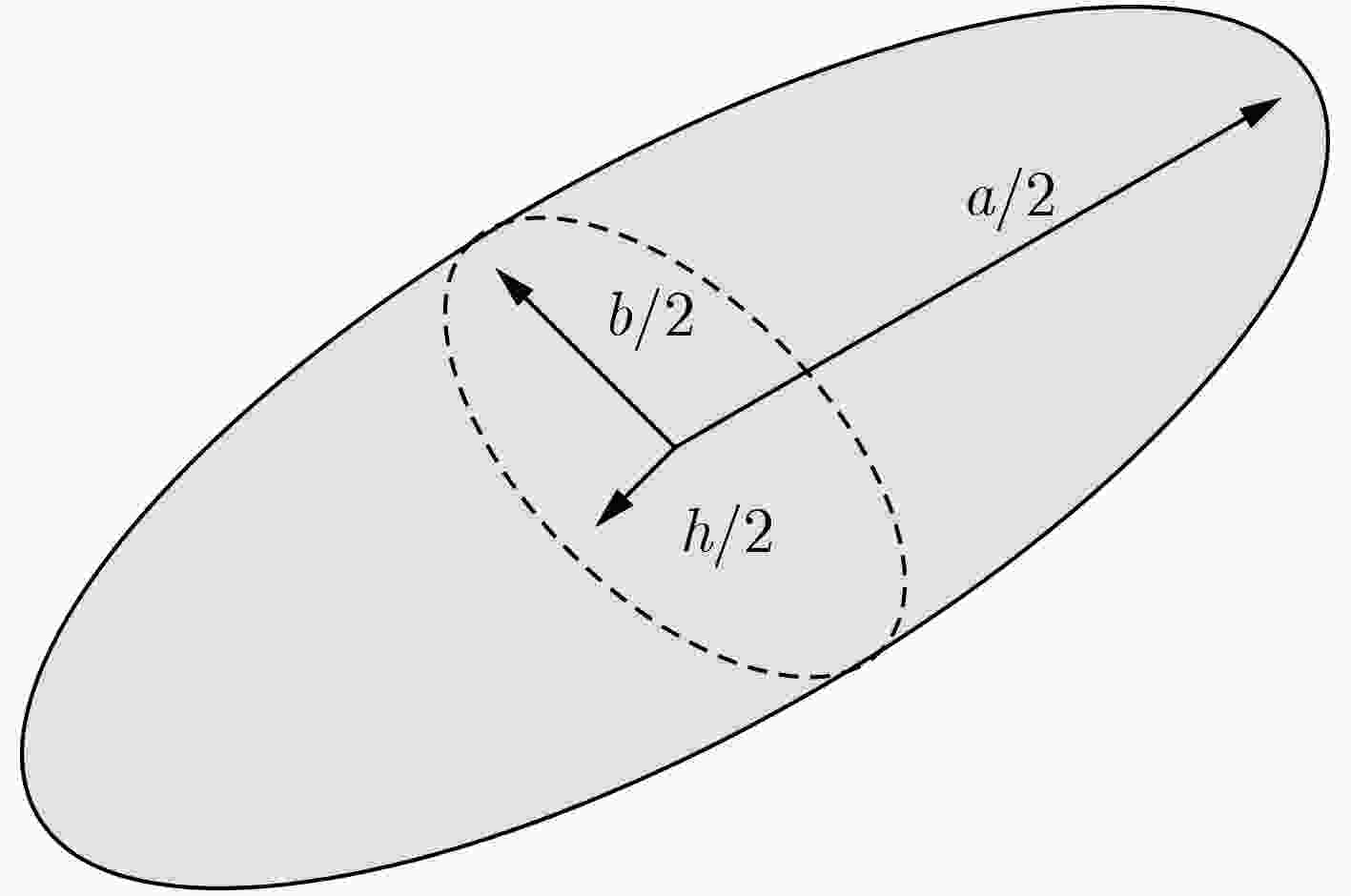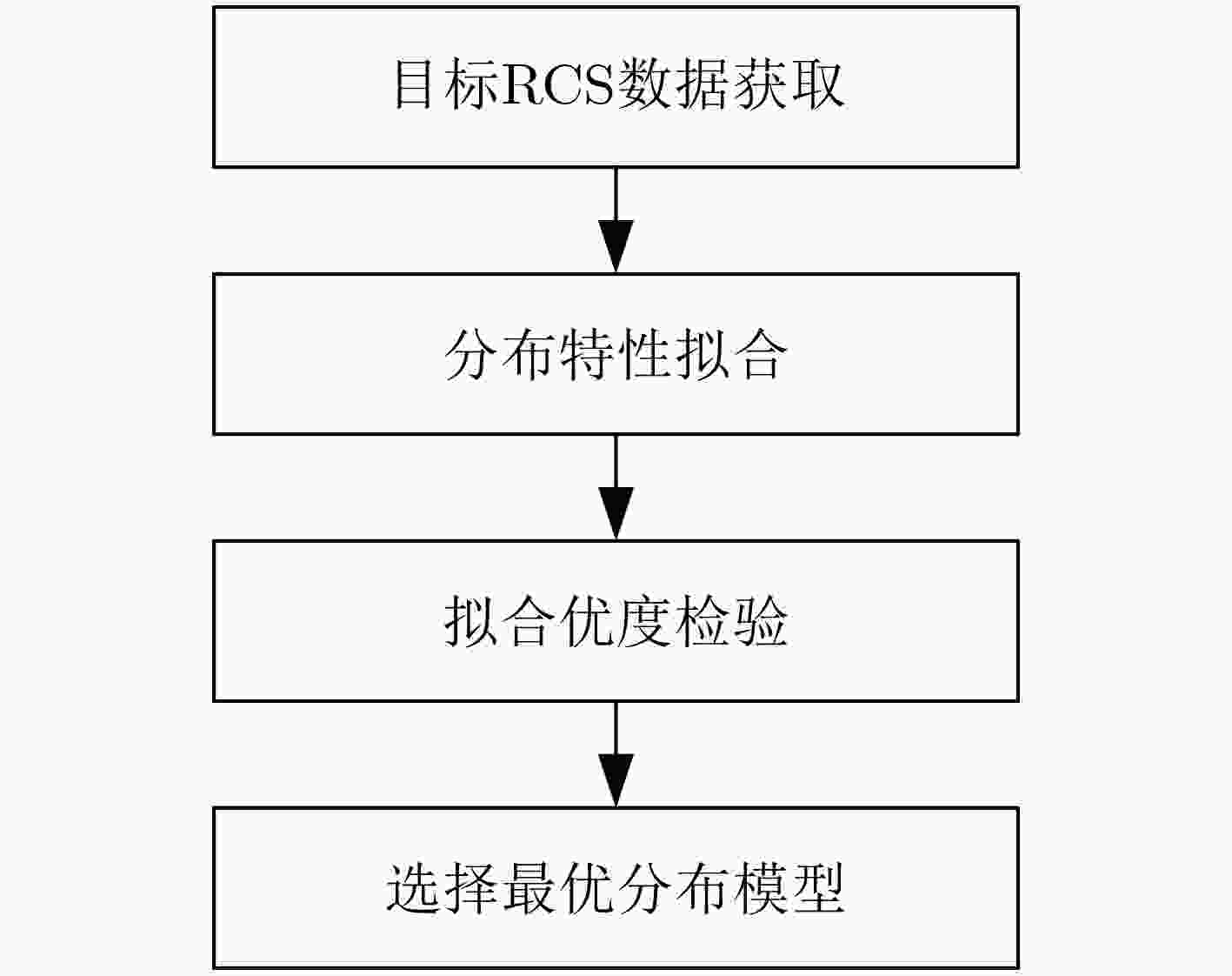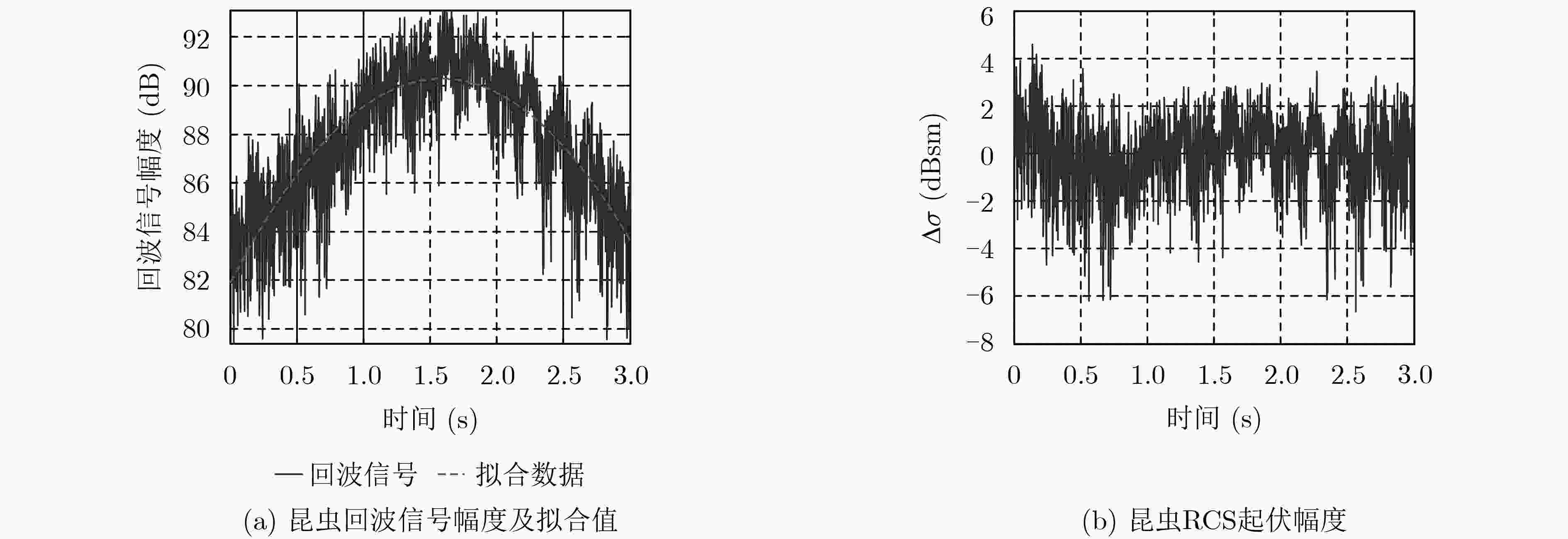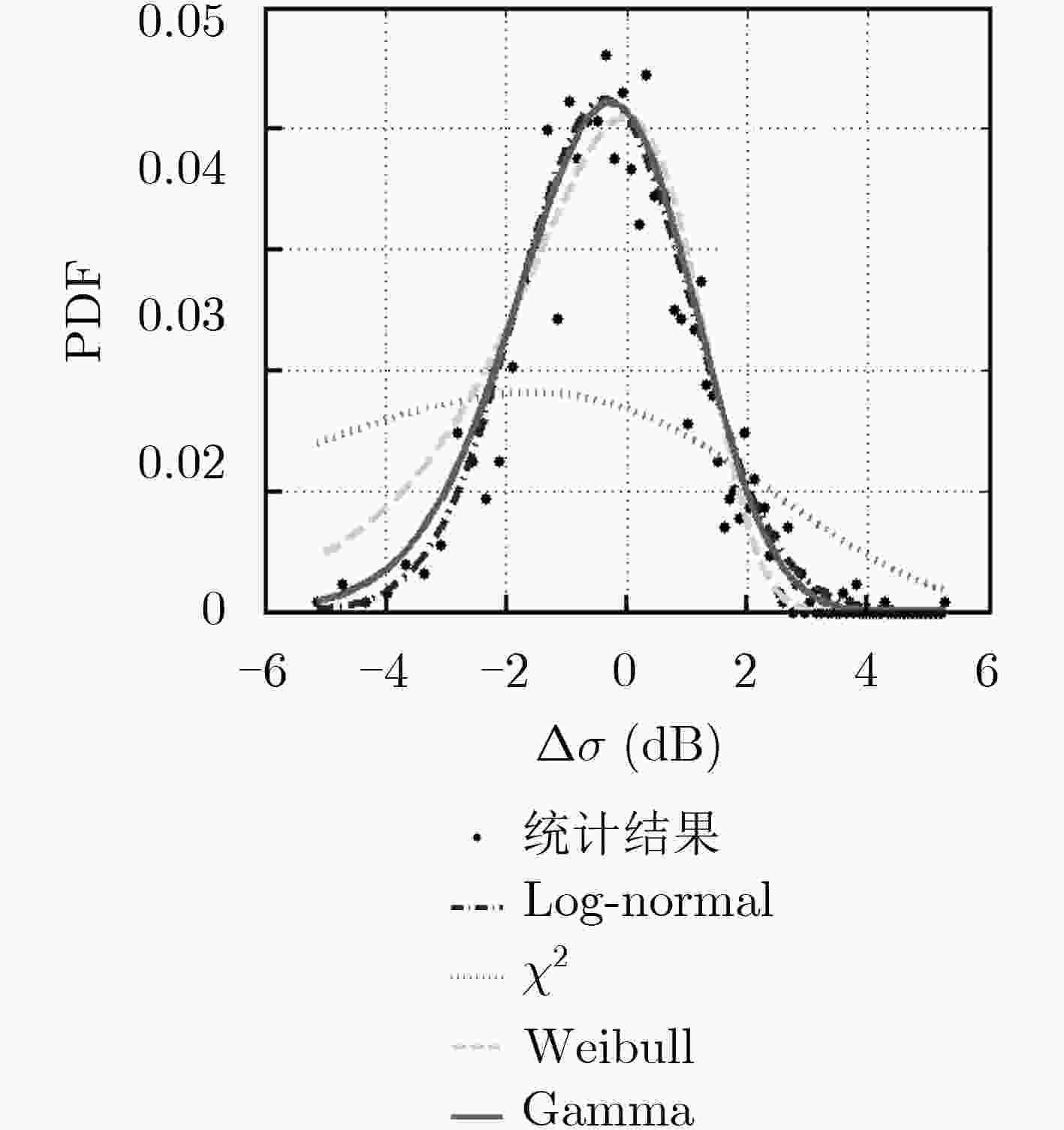Analysis of Insect RCS Characteristics
-
摘要:
昆虫雷达是观测昆虫迁飞最有效的工具。研究昆虫的雷达散射截面积(RCS)特性对于昆虫雷达目标识别有着重要意义。该文将分析昆虫的静态RCS特性和动态RCS特性。首先,基于实测的X波段全极化昆虫RCS数据,分析昆虫的静态RCS特性,包括水平和垂直极化RCS随体重变化规律以及昆虫极化方向图随体重的变化规律。其次,总结当前通过电磁仿真研究昆虫RCS特性所用到的介质和几何形状模型,并对比了水、脊髓、干皮肤和壳质与血淋巴混合物4种介质和等体型扁长椭球体、等质量扁长椭球体和三轴椭球体3种几何模型组成的12种介质模型,经过电磁仿真结果与实测数据相对比发现脊髓介质等质量扁长椭球体模型与实测昆虫RCS特性最接近。然后,基于Ku波段高分辨昆虫雷达外场实测昆虫回波数据,分析了昆虫动态RCS的起伏特性,将实测昆虫动态RCS起伏数据与4种经典的RCS起伏分布模型χ2, Log-normal, Weibull和Gamma分布分别进行了拟合分析,从最小二乘拟合误差和拟合优度检验结果可以看出,相比于其他3种模型,Gamma分布可以较好地描述昆虫目标RCS起伏的统计特性。最后,综述了昆虫RCS特性在昆虫雷达测量昆虫朝向、体重等参数测量的应用。
-
关键词:
- 昆虫雷达 /
- 昆虫雷达散射截面积特性 /
- 电磁仿真 /
- 雷达散射截面积起伏
Abstract:Insect radar is the most effective tool for insect migration observation. In order to realize target recognition of insect radar, it is important to study the RCS characteristics of insects. This paper will analyze the static and dynamic Radar Cross Section (RCS) characteristics of insects. Firstly, based on the measured X-band fully-polarimetric RCS data, the static RCS characteristics of insects are analyzed, including the variations of horizontal and vertical polarization RCS with body weight respectively, and the variation of insect polarization pattern with body weight. Secondly, the dielectrics and geometric models currently used to study the RCS characteristics of insects are summarized by electromagnetic simulation. Twelve dielectric models consisting of four dielectrics (including water, spinal cord, dry skin, and chitin and hemolymph mixture) and three geometric models (including equivalent size prolate spheroid, equivalent mass prolate spheroid and triaxial prolate spheroid) are compared, and it be found that the RCS characteristics of equivalent mass prolate spheroid are closest to that of the real insects. Then, the fluctuation characteristics of insect dynamic RCS are analyzed based on the insect echo data measured in field by a Ku-band high-resolution insect radar. The measured insect dynamic RCS fluctuation data are fitted with four classical RCS fluctuation distribution models (χ2, Log-normal, Weibull and Gamma distribution), respectively. It can be seen from the least square error of fitting and goodness of fit test that Gamma distribution gives the best description of the statistical characteristics of insect RCS fluctuations. Finally, the application of insect RCS characteristics to insect orientation, mass and body length measurements for insect radars is summarized.
-
表 1 实验昆虫样本信息
序号 昆虫名称 体长(mm) 体宽(mm) 体重(mg) 1 未辨识飞蛾1#1 11.1 2.8 25.6 2 未辨识飞蛾1#2 15.0 3.0 35.5 3 枯叶蛾#1 16.7 4.0 72.2 4 枯叶蛾#2 17.9 5.0 105.0 5 小地老虎 19.5 4.9 218.4 6 霜天蛾 34.8 9.1 319.7 7 未辨识飞蛾2 22.9 6.8 400.7 8 甘薯天蛾#1 38.9 9.0 530.1 9 甘薯天蛾#2 40.0 12.4 680.4 10 甘薯天蛾#3 36.8 10.2 935.3 表 2 介质密度及相对介电常数
介质 密度ρ(g/cm3) X波段相对介电常数 水 1.000 60.30-33.10j 脊髓 1.038 23.80-10.84j 干皮肤 1.045 31.30-14.41j 壳质与血淋巴混合物 1.260 34.30-18.60j 表 3 等尺寸椭球体模型质量百分比误差(%)
昆虫序号 水 脊髓 干皮肤 壳质混合物 1 –77.99 –84.75 –86.00 –124.27 2 –99.12 –106.68 –108.08 –150.88 3 –93.78 –101.14 –102.49 –144.16 4 –123.15 –131.63 –133.19 –181.17 5 –12.25 –16.51 –17.30 –41.43 6 –371.97 –389.91 –393.21 –494.69 7 –38.37 –43.63 –44.59 –74.34 8 –211.23 –223.05 –225.23 –292.14 9 –373.30 –391.29 –394.60 –496.36 10 –114.34 –122.48 –123.98 –170.06 平均误差 –151.55 –161.11 –162.87 –216.95 表 4 等质量椭球体模型体长百分比误差(%)
昆虫序号 水 脊髓 干皮肤 壳质混合物 1 17.48 18.50 18.69 23.60 2 20.51 21.49 21.67 26.41 3 19.79 20.78 20.96 25.74 4 23.48 24.42 24.59 29.15 5 3.78 4.97 5.18 10.91 6 40.38 41.12 41.25 44.80 7 10.26 11.37 11.57 16.91 8 31.51 32.35 32.51 36.59 9 40.44 41.18 41.31 44.86 10 22.44 23.40 23.57 28.19 平均误差 23.01 23.96 24.13 28.72 表 5 三轴椭球体模型高度百分比误差(%)
昆虫序号 水 脊髓 干皮肤 壳质混合物 1 43.82 45.87 46.23 55.41 2 49.78 51.62 51.94 60.14 3 48.39 50.28 50.62 59.04 4 55.19 56.83 57.12 64.43 5 10.91 14.17 14.75 29.29 6 78.81 79.59 79.72 83.18 7 27.73 30.37 30.84 42.64 8 67.87 69.05 69.25 74.50 9 78.87 79.65 79.78 83.23 10 53.34 55.05 55.35 62.97 平均误差 51.47 53.25 53.56 61.49 表 6 等质量椭球体模型RCS百分比误差(%)
介质 极化方向平行
体轴RCS极化方向垂直
体轴RCS水 224.3 22.1 脊髓 65.9 19.7 干皮肤 101.2 6.7 壳质与血淋巴混合物 68.8 32.8 表 7 分布函数表达式
分布函数 表达式 参数 ${\chi ^2}$ $p\left( \sigma \right) = \dfrac{m}{ {\varGamma \left( m \right)\bar \sigma } }{\left[ {\dfrac{ {m\sigma } }{ {\bar \sigma } } } \right]^{m - 1} }\exp \left[ {\dfrac{ { - m\sigma } }{ {\bar \sigma } } } \right]$ $\bar \sigma $为平均值,$2m$为自由度 Log-normal $p\left( \sigma \right) = \dfrac{1}{{\sigma \sqrt {4{\pi }\ln \rho } }}\exp \left\{ {\dfrac{{ - {{\left( {\ln \sigma - {\sigma _0}} \right)}^2}}}{{4\ln \rho }}} \right\}$ ${\sigma _0}$为中值,$\rho $为平均中值比 Gamma $p\left( \sigma \right) = \dfrac{1}{ { {\beta ^\alpha }\varGamma \left( \alpha \right)} }{\sigma ^{\alpha - 1} }\exp \left( { - \dfrac{\sigma }{\beta } } \right)$ $\alpha $是形状参数,$\beta $是尺度参数 Weibull $p\left( \sigma \right) = \dfrac{b}{a}{\left( {\dfrac{\sigma }{a}} \right)^{b - 1}}\exp \left( { - {{\left( {\dfrac{\sigma }{a}} \right)}^b}} \right)$ $a$是尺度参数,$b$是形状参数 表 8 昆虫RCS起伏PDF分布拟合误差
昆虫序号 RCS起伏
样本点数Log-normal ${\chi ^2}$ Gamma Weibull 1 1500 0.0812 0.3870 0.0747 0.0960 2 1250 0.1288 0.5774 0.1204 0.1307 3 1280 0.0724 0.7709 0.0710 0.1102 4 1340 0.0992 0.5652 0.0960 0.1262 5 1460 0.0861 0.3555 0.0765 0.0903 均值 0.0935 0.5312 0.0877 0.1107 表 9 昆虫RCS起伏PDF分布K-S检验参数D值
昆虫序号 RCS起伏
样本点数Log-normal χ2 Gamma Weibull 1 1500 0.0221 0.2141 0.0181 0.0370 2 1250 0.0306 0.2045 0.0169 0.0266 3 1280 0.0195 0.2094 0.0096 0.0342 4 1340 0.0211 0.1831 0.0181 0.0356 5 1460 0.0258 0.1583 0.0145 0.0271 均值 0.0238 0.1939 0.0154 0.0321 -
HU Gao, LIM K S, HORVITZ N, et al. Mass seasonal bioflows of high-flying insect migrants[J]. Science, 2016, 354(6319): 1584–1587. doi: 10.1126/science.aah4379 吴秋琳, 姜玉英, 胡高, 等. 中国热带和南亚热带地区草地贪夜蛾春夏两季迁飞轨迹的分析[J]. 植物保护, 2019, 45(3): 1–9.WU Qiulin, JIANG Yuying, HU Gao, et al. Analysis on spring and summer migration routes of fall armyworm (Spodoptera frugiperda) from tropical and southern subtropical zones of China[J]. Plant Protection, 2019, 45(3): 1–9. HU Cheng, WANG Yixuan, WANG Rui, et al. An improved radar detection and tracking method for small UAV under clutter environment[J]. Science China Information Sciences, 2019, 62(2): 29306. doi: 10.1007/s11432-018-9598-x ZHOU Chao, WANG Rui, and HU Cheng. Equivalent point estimation for small target groups tracking based on MLE[J]. Science China Information Sciences, 2019. doi: 10.1007/s11432-019-1518-x SMITH A D, RILEY J R, and GREGORY R D. A method for routine monitoring of the aerial migration of insects by using a vertical-looking radar[J]. Philosophical Transactions of the Royal Society B: Biological Sciences, 1993, 340(1294): 393–404. doi: 10.1098/rstb.1993.0081 GLOVER K M, HARDY K R, LANDRY C R, et al. Radar characteristics of known insects in free flight[C]. The 12th Conference on Radar Meteorology, Oklahoma, USA, 1966: 254–258. RILEY J R. Angular and temporal variations in the radar cross-sections of insects[J]. Proceedings of the Institution of Electrical Engineers, 1973, 120(10): 1229–1232. doi: 10.1049/piee.1973.0251 RILEY J R, VAUGHN C R, WOLF W, et al. Quantitative analysis of radar returns from insects[C]. A Workshop Held at NASA Wallops Flight Center, Wallops Island, USA, 1978: 131–158. RILEY J R. Radar cross section of insects[J]. Proceedings of the IEEE, 1985, 73(2): 228–232. doi: 10.1109/PROC.1985.13135 ALDHOUS A C. An investigation of the polarisation dependence of insect radar cross sections at constant aspect[D]. [Ph.D. dissertation], Cranfield University, 1989. MURTON R K and WRIGHT E N. The Problems of Birds as Pests[M]. New York: Academic Press, 1968: 53–86. SCHAEFER G W. Radar observations of insect flight[C]. Insect Flight Symposia of the Royal Entomological Society, London, UK, 1976: 157–197. MIRKOVIC D, STEPANIAN P M, WAINWRIGHT C E, et al. Characterizing animal anatomy and internal composition for electromagnetic modelling in radar entomology[J]. Remote Sensing in Ecology and Conservation, 2019, 5(2): 169–179. doi: 10.1002/rse2.94 WANG Rui, HU Cheng, LIU Changjiang, et al. Migratory insect multifrequency radar cross sections for morphological parameter estimation[J]. IEEE Transactions on Geoscience and Remote Sensing, 2019, 57(6): 3450–3461. doi: 10.1109/TGRS.2018.2884926 HU Cheng, LI Wenqing, WANG Rui, et al. Insect flight speed estimation analysis based on a full-polarization radar[J]. Science China Information Sciences, 2018, 61(10): 109306. doi: 10.1007/s11432-018-9484-2 WANG Rui, HU Cheng, FU Xiaowei, et al. Micro-Doppler measurement of insect wing-beat frequencies with W-band coherent radar[J]. Scientific Reports, 2017, 7(1): 1396. doi: 10.1038/s41598-017-01616-4 HU Cheng, KONG Shaoyang, WANG Rui, et al. Identification of migratory insects from their physical features using a decision-tree support vector machine and its application to radar entomology[J]. Scientific Reports, 2018, 8(1): 5449. doi: 10.1038/S41598-018-23825-1 汪兵. 非独立同分布起伏目标建模与检测算法研究[D].[博士论文], 电子科技大学, 2017.WANG Bing. Research on modeling and the detection algorithm of non-ⅡD fluctuation targets[D].[Ph.D. dissertation], University of Electronic Science and Technology of China, 2017. SWERLING P. Probability of detection for fluctuating targets[J]. IRE Transactions on Information Theory, 1960, 6(2): 269–308. doi: 10.1109/TIT.1960.1057561 WEINSTOCK W. Target cross section models for radar system analysis[D]. [Ph.D. dissertation], University of Pennsylvania, 1964. LEWINSKI D. Nonstationary probabilistic target and clutter scattering models[J]. IEEE Transactions on Antennas and Propagation, 1983, 31(3): 490–498. doi: 10.1109/TAP.1983.1143067 SHNIDMAN D A. Expanded Swerling target models[J]. IEEE Transactions on Aerospace and Electronic Systems, 2003, 39(3): 1059–1069. doi: 10.1109/TAES.2003.1238757 ROSE M, HAIMOV S, and MOORE R K. Optimum detection of Weibull-distributed targets[C]. OCEANS '93, Victoria, Canada, 1993: Ⅱ/5-Ⅱ/9. doi: 10.1109/OCEANS.1993.326056. SHNIDMAN D A. Calculation of probability of detection for log-normal target fluctuations[J]. IEEE Transactions on Aerospace and Electronic Systems, 1991, 27(1): 172–174. doi: 10.1109/7.68161 SLOCUMB B J and KLUSMAN Ⅲ M E. A multiple model SNR/RCS likelihood ratio score for radar-based feature-aided tracking[J]. SPIE, 2005, 5913: 540–551. doi: 10.1117/12.615288 SHI Weiqiang, SHI Xiaowei, and XU Le. Radar Cross Section (RCS) statistical characterization using Weibull distribution[J]. Microwave and Optical Technology Letters, 2013, 55(6): 1355–1358. doi: 10.1002/mop.27557 林刚, 许家栋. 目标RCS动态数据的分布特征研究[J]. 现代雷达, 2006, 28(2): 18–20. doi: 10.3969/j.issn.1004-7859.2006.02.006LIN Gang and XU Jiadong. Study of the statistical characterization of targets’ RCS dynamic data[J]. Modern Radar, 2006, 28(2): 18–20. doi: 10.3969/j.issn.1004-7859.2006.02.006 史伟强, 徐乐, 史小卫, 等. 基于完备对数正态分布模型的隐形飞行器动态RCS统计特性研究[J]. 电子与信息学报, 2013, 35(9): 2121–2125. doi: 10.3724/SP.J.1146.2012.01161SHI Weiqiang, XU Le, SHI Xiaowei, et al. Dynamic RCS statistic characterization of stealth aircraft using complete lognormal distribution[J]. Journal of Electronics &Information Technology, 2013, 35(9): 2121–2125. doi: 10.3724/SP.J.1146.2012.01161 沈鹏. 海面舰船RCS起伏分布模型研究[J]. 指挥控制与仿真, 2019, 41(4): 37–39. doi: 10.3969/j.issn.1673-3819.2019.04.008SHEN Peng. RCS fluctuation distribution models research of Ship Target on Sea[J]. Command Control &Simulation, 2019, 41(4): 37–39. doi: 10.3969/j.issn.1673-3819.2019.04.008 SKOLNIK M I. Radar Handbook[M]. 3rd ed. New York, USA: McGraw-Hill, 2008. HU Cheng, LI Weidong, WANG Rui, et al. Accurate insect orientation extraction based on polarization scattering matrix estimation[J]. IEEE Geoscience and Remote Sensing Letters, 2017, 14(10): 1755–1759. doi: 10.1109/LGRS.2017.2733719 HOBBS S E and ALDHOUS A C. Insect ventral radar cross-section polarisation dependence measurements for radar entomology[J]. IEE Proceedings-Radar, Sonar and Navigation, 2006, 153(6): 502–508. doi: 10.1049/ip-rsn:20060019 VAUGHN C R. Birds and insects as radar targets: A review[J]. Proceedings of the IEEE, 1985, 73(2): 205–227. doi: 10.1109/proc.1985.13134 MIRKOVIC D, STEPANIAN P M, KELLY J F, et al. Electromagnetic model reliably predicts radar scattering characteristics of airborne organisms[J]. Scientific Reports, 2016, 6(1): 35637. doi: 10.1038/srep35637 NELSON S O, BARTLEY P G Jr, and LAWRENCE K C. RF and microwave dielectric properties of stored-grain insects and their implications for potential insect control[J]. Transactions of the ASAE, 1998, 41(3): 685–692. doi: 10.13031/2013.17194 HOBBS S, ALLSOPP K, and WOLF W. Signal analysis for an entomological radar with a vertical Nutating beam[R]. College of Aeronautics Report 9919, 2003. DOWDY P C. RCS probability distribution function modeling of a fluctuating target[C]. The 1991 IEEE National Radar Conference, Los Angeles, USA, 1991: 164–168. doi: 10.1109/NRC.1991.114752. RILEY J R. Collective orientation in night-flying insects[J]. Nature, 1975, 253(5487): 113–114. doi: 10.1038/253113a0 CHAPMAN J W, NESBIT R L, BURGIN L E, et al. Flight orientation behaviors promote optimal migration trajectories in high-flying insects[J]. Science, 2010, 327(5966): 682–685. doi: 10.1126/science.1182990 HARMAN I T and DRAKE V A. Insect monitoring radar: Analytical time-domain algorithm for retrieving trajectory and target parameters[J]. Computers and Electronics in Agriculture, 2004, 43(1): 23–41. doi: 10.1016/j.compag.2003.08.005 HU Cheng, LI Weidong, WANG Rui, et al. Insect biological parameter estimation based on the invariant target parameters of the scattering matrix[J]. IEEE Transactions on Geoscience and Remote Sensing, 2019, 57(8): 6212–6225. doi: 10.1109/TGRS.2019.2904869 CHAPMAN J W, SMITH A D, WOIWOD I P, et al. Development of vertical-looking radar technology for monitoring insect migration[J]. Computers and Electronics in Agriculture, 2002, 35(2/3): 95–110. doi: 10.1016/s0168-1699(02)00013-3 DRAKE V A, CHAPMAN J W, LIM K S, et al. Ventral-aspect radar cross sections and polarization patterns of insects at X band and their relation to size and form[J]. International Journal of Remote Sensing, 2017, 38(18): 5022–5044. doi: 10.1080/01431161.2017.1320453 HU Cheng, LI Weidong, WANG Rui, et al. Accurate insect body length extraction based on the invariant target parameters[C]. 2018 IEEE International Conference on Computational Electromagnetics, Chengdu, China, 2018: 1–3. doi: 10.1109/COMPEM.2018.8496592. -






 下载:
下载:








 下载:
下载:
